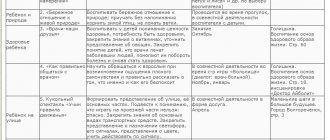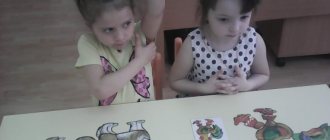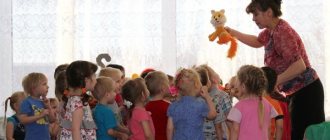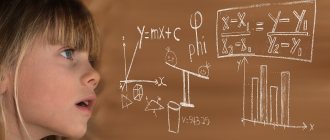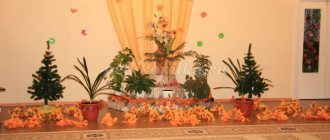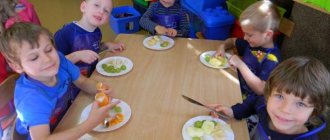Types, tasks and techniques of conducting musical games in the preparatory group (6–7 years old)
Before choosing the type of game, you need to clearly formulate the goals and objectives that you want to achieve.
Goals and objectives of the game
Each teacher sets specific goals, but relies on some general ones. These include:
- Development of children's creative abilities.
- Formation of musical ear and taste.
- Introducing children to the basics of musical art.
- Development of musical and sensory abilities.
- Instilling interest in independent activity in art.
Types and techniques of conducting musical games
When preparing for classes, educators choose methods and techniques with which to achieve their goals.
Basic Techniques
- Visual: visual-auditory and visual-visual. The technique is based on performing or listening to musical compositions, comparing and contrasting them. Auditory perception can be supported by visual perception, that is, by the use of cards, musical toys and the instruments themselves.
- Verbal: story, explanation, conversation, explanation. The teacher conveys knowledge about music through dialogue. Speech is aimed at its emotional and figurative content.
- Practical: the teacher performs rhythmic movements, singing, playing instruments.
In order for upbringing and learning to be creative, developmental in nature, each of the three main methods - visual, verbal and practical - must be used in an increasing degree of complexity: from direct influence (explanatory and illustrative method) through consolidation, exercises (reproducing and creative), creating search situations ( showing options for completing a task) to problem-based education and training (children’s independent search for ways to act). The degree to which pedagogical methods become problematic depends on the age of the children, the tasks of education and training, and the children’s accumulation of experience in independent and creative actions. In older preschool age, the proportion of problem tasks that children complete independently increases.
G.N. Nedonoskova
Methods and techniques for musical education of preschool children: https://docplayer.ru/27665430-Metody-i-priemy-muzykalnogo-vospitaniya-detey-doshkolnogo-vozrasta.html
Main types of game
Based on tasks and actions, games are divided into three main types: didactic, active, and singing games.
Didactic games
Children are expected to be sedentary and divided into teams. The competition is about the ability to accurately and quickly identify instruments, notes or a piece of music from pictures or by ear.
Props are prepared in advance for the game. You can purchase ready-made educational material or create it yourself. When creating products, it is advisable to involve children, this will become an entertaining job for them.
Materials for games:
- printed or handmade products (images, cards, etc.);
- musical instruments and toys;
- audio recordings.
During the game, preschoolers follow the rules by showing corresponding pictures or raising flags when they hear the desired name or melody. To increase interest in the task, an award is given at the end.
Didactic games are used in different classes. For example, with the help of musical instruments or their images, you can study counting or develop speech.
Outdoor games
This type is based on the dynamics of action. Children listen to compositions and react to sounds with movements. According to the degree of dynamism, the following games are distinguished:
- High mobility: involves a large group of children. The game involves running and jumping.
- Moderate mobility: involves working in a team or taking turns completing tasks. The course of the game assumes a calmer movement in space.
- Low mobility: low intensity with calm movement of children.
In addition to musical activities, this type of game is used taking into account the theme as physical exercises, competitions and entertaining moments.
Singing games
Based on knowledge of songs of different formats. In this connection, they are divided into three groups:
- round dances: the content and melodies of play songs determine the children’s movements;
- folk: contain traditional texts, most often used at folk festivals or walks;
- with songs for dramatization: they have texts with a detailed plot and several images, which determine the actions of preschoolers.
Depending on the content of the text, game songs can move from one group to another.
You are presented with the main types of music games. Remember that the list is not finite and the technique allows for combining them.
Conducting musical and didactic games in the preparatory group of kindergarten
To improve children's perception, the game must be skillfully conveyed. Therefore, it is necessary to understand its features and prepare for its implementation, i.e. drawing up a plan, rehearsal (or mental playback), knowledge of the texts. To get started, refer to the game files.
Game card index
There are many games on the Internet that vary in theme and content. The examples presented are compiled in accordance with the Federal State Educational Standard.
Technological map of the game “Mill”: table
| Name | Target | Techniques | Materials | Progress of the game |
| "Mill" | Teach children to distinguish between the strong and weak beats of a beat through hand movements | Visual (visual-auditory) | Playing instrument or audio recording | Children don’t have to be placed in a special order; let them stand scattered. The teacher shows the position of the arms: not tense, slightly bent at the elbows and raised to the sides. Movements to music depend on the beat:
It is better to first carry out the movements without musical accompaniment and show them by personal example. The emphasis should be placed on tension and relaxation of the hands so that children feel them well. |
The exercise is also aimed at training plastic movements, allowing you to perform complex exercises in the future.
Any music can be used. The example shows a composition by T. Lomova.
Music by T. Lomova
Technological map of the game “Magic Box”: table
| Name | Target | Techniques | Materials | Progress of the game |
| "Magic Box" | Teach children to distinguish instruments by sound | Visual and practical |
| At the beginning of the game, the teacher shows and allows the children to examine the box from all sides. The guys must name the instruments depicted on it. Then he talks about the magic of this box, because it is not simple, because musical instruments live inside. The teacher places the box next to the laid out cards. Then everyone listens to the recordings and guesses the instruments. The guesser takes out the tool and places it next to the matching picture. For children in the preparatory group, the task can be simple, so you can complicate it: the guesser needs to play the instrument to the music. |
Visual aid of the game: photo
Box and cards
There may be a children's favorite toy inside that participates in the game
The child guessed the instrument
Musical and didactic game “Who is buzzing?”
(to develop a sense of rhythm, rhythmic and pitch hearing)
Goal : developing the ability to correctly sing long and short sounds in different words in a specific gaming situation, also using sounds of different pitches: high and low.
Materials and equipment: flannelgraph, cards with images of various vehicles (locomotive, plane, car, steamship), icons indicating the duration of sounds.
The music director shows the children flannelgraph cards depicting various vehicles (a locomotive, an airplane, a car, a steamship) and says: “You are all very familiar with this transport and, of course, you have heard it give a signal.”
Children remember how every vehicle hums.
The teacher-driver says: “Transport doesn’t just give a signal. This is his song. Let's try to sing these songs." Then he invites the children to choose a transport card, install it on a flannelgraph, and lay out a rhythmic pattern next to the icons indicating the duration of sounds. The music director reminds the children that they can sing the song not only with long and short sounds, but also with high and low sounds, laying them out in height on a flannelgraph. Children perform a game task.
For this game with children, you need to consolidate your knowledge of high and low, long and short sounds.
Timing game plan
To achieve the set goals, it is important to clearly construct and implement an algorithm of actions.
Algorithm of actions taking into account time
In the preparatory group, the duration of the game is on average 15–20 minutes. This time allows you to go through four stages:
- Introductory part: motivating children and activating their attention (2 minutes).
- Explanation of the rules (1–2 minutes).
- Carrying out the game (10–15 minutes).
- Completion: evaluation of results, encouragement of the most active (1–2 minutes).
The time plan of children's activities is closely related to the awareness of its goals and means. Questions like: “Why do you need this?”, “What will you do with this machine?”, “What first, and what later?” - direct the child’s attention to the goals and means of his actions.
E.O. Smirnova
Features of communication with preschoolers: https://pedlib.ru/Books/1/0290/index.shtml?from_page=45
Examples of materials with an algorithm: table
| "Song - Dance - March" | |
| Stage | Content |
| Introductory part | The teacher shows the children a drawing of a house. Children look at it and guess who lives in it. |
| Explanation of the rules | “Guys, what do you think is happening in the house now? Do you want to know? Then listen to the music and try to guess.” |
| Carrying out the game | The teacher starts playing music or an audio recording and the children guess the actions. The person who guesses correctly is allowed to open the shutters; an image of movements is visible in the window. For the correct answer, the child receives a card. |
| Completion | After all the melodies have been guessed, a count is carried out. The one with the most cards wins. |
| "We walk in circles" | |
| Stage | Content |
| Introductory part | Guys, let's play a little and remember the song we learned in the last lesson. |
| Explanation of the rules | Everyone stand in a circle and hold hands. The first presenter will be (name). He/she enters the circle and moves inside it in different directions. You and I walk in a circle and sing a song, when it ends, (name) will show us the movement, and we will repeat it. Afterwards he/she will choose another presenter. Ready? Begin. |
| Carrying out the game | Children walk in a circle and sing: We walk in a circle, one after another. Hey guys, don't yawn! Everything that (name) shows us, We will repeat together! Next, the leader makes a movement, everyone repeats it. Then it changes and so on. |
| Completion | As soon as the turn reaches the first leader, the game can be stopped and rested. |
| “Who knows more?” | |
| Stage | Content |
| Introductory part | “Guys, let’s imagine that you go to a musical instrument store and buy a guitar, tambourine and double bass. To choose the right one to buy, you need to remember what they look like.” |
| Explanation of the rules | “Now I will show you cards with tools, and you try to guess what it is called.” |
| Carrying out the game | The teacher shows the cards to the children one by one. The child who guesses it takes it for himself. The game continues until the cards run out. |
| Completion | Then the count is carried out. The one with the most cards wins. |
Game “Walking in Circles”: video
Game “Find out the instrument”: video
The card index of musical and didactic games is intended for children in the preparatory group for school
Card index
musical and didactic games
school preparatory group
Games to develop pitch hearing.
Musical stairs.
Game material:
Four sets of cards - red, yellow, green on both sides. One set includes 12 cards (6 pairs). Each pair consists of a card on which a ladder is drawn, cards with images of circles corresponding to the steps of the ladder. There are only two cards with 3 steps up and down; 2 x 4 steps; 2 x 5 steps. Metallophone, screen.
Progress of the game:
From 3 to 7 children play, one is the leader. The leader divides all the cards equally: cards with circles are folded in front of him, cards with ladders are distributed equally to the players. Then he shows a card with circles, the children sing the sounds in a certain order, down or up. When asked by the presenter who has such a ladder, the one with such a card answers. The one who gets paired cards first wins.
Bells.
Game material:
12 paired cards. On their staves are the notes C-2, A-1, F-1. 12 cards with images of bells on rulers corresponding to these notes. Cards with individual notes and bells: red, blue, green and yellow. Metallophone, screen.
Progress of the game:
The presenter hands out multi-colored cards with bells to the children. Cards with notes and a metallophone are hidden behind a screen. Children sing the song “Jingle Bells”, then the presenter shows the card from the back, plays a sound, and invites the children to guess what note it is. The child guesses and covers the image on his card. The first one to collect paired cards wins.
Miracle ladder.
Game material:
A ladder with steps, each step is a different color, 5 chips that match the color of the steps.
Progress of the game:
The teacher plays a certain melody, the children lay out this melody on the stairs (movement up, down, across a step, on one sound, etc.)
Scientist grasshopper.
Game material:
A picture with the image of flowers and a scientific grasshopper, a metallophone.
Progress of the game:
Here is a learned grasshopper. He jumps on the flowers as directed. Come on, grasshopper, jump to the third flower, and from there down. And now to the fifth flower - and down again. And now onto the second flower - and down.
Note.
Singing the words “Hop, hop, hop!” accompany with a movement of your hand. The movement of the grasshopper through the flowers is accompanied by a melodic instrument. At this time, the child carefully looks at the pictures and chooses the music that suits the adult played. You can cut out a grasshopper from cardboard and attach it to the tip of the pointer. While singing, the child will be able to control the grasshopper, singing the words “Leap, hop...”.
Games to develop a sense of rhythm.
Fun Train.
Game material:
A small toy steam locomotive with carriages and a piano.
Progress of the game:
The teacher performs a musical piece, conveying the movement of the locomotive: at first it moves slowly, then faster and very quickly, by the end of the play the music slows down and stops. After re-performing the play, the teacher invites children to imagine themselves as a locomotive and carriages and move in accordance with the music.
Our trip.
Game material:
Metallophone, tambourine, spoons, drum.
Progress of the game:
The teacher invites the children to come up with a story about their journey, which can be depicted on some musical instrument. For example: Olya left the house and ran down the stairs, then jumped rope, and when she got tired of jumping, she decided to go home again and ran up the stairs to her apartment (shown on the metallophone).
Complete the task.
Game material:
Flannelograph, cards with images of long and short sounds, musical instruments (metallophone, button accordion, triol, piano).
Progress of the game:
The teacher plays a rhythmic pattern on one of the instruments, the child must lay out this pattern on a flannelgraph. Children who sit at the table lay out a rhythmic pattern on the table.
Games for different timbre colors.
Musical riddles.
Game material:
Metallophone, triangle, bells, tambourine, harp, cymbals.
Progress of the game:
Children sit in a semicircle in front of a screen, behind which there are musical instruments and toys on the table. The child leader plays a melody or rhythmic pattern on one of the instruments, and the children guess. For the correct answer, the child receives a chip. The one with the most chips wins.
Musical instruments.
Game material:
8 lotto-type cards with colored stripes at the bottom (2 red, 2 green, 2 yellow). There are 4 cards of each color with two empty cells. The rest have one empty cell. On all other cells there is a contour image of musical instruments, repeated 4 times; on 28 small cards the same musical instruments are depicted, the reverse side of which corresponds to the color of the stripes on the large cards. Musical instruments: triola, accordion, drum, tambourine, zither, domra, metallophone.
Progress of the game:
Four children and a fifth leader play. After singing the song, the leader reminds the sound of each instrument, and everyone begins to play. To the leader’s question: “What instrument is playing?”, the child who has a stripe on the card that matches the color of the leader’s card answers. The winner is the one who is the first to cover his drawings on the cards with a color image of musical instruments.
Whom did the bun meet?
Target:
To develop children's understanding of registers (high, medium, low).
Game material:
The card is made of thick cardboard, divided into two parts: on the left is a cheerful bun; a window is cut out on the right. The reverse side is sealed. A strip of cardboard in the form of a ruler is inserted into the slot, divided into four equal
parts, each of which depicts one or another character from a fairy tale (hare, fox, wolf, bear). The ruler must move so that one of the characters appears in the window each time.
Progress of the game:
Children remember the fairy tale “Kolobok”, list all the heroes who meet the Kolobok on the way. Then the teacher performs musical pieces in different sequences that characterize the characters of the fairy tale. Each piece sounds in a certain register: “hare” - high, “fox” - medium, “wolf” - low, “bear2” - very low. After listening to a play, children guess who is depicted in the music (who the bun met) and move the ruler.
Musical repertoire:
“Who did the bun meet?” Levkodimova.
Dynamics difference games.
Sea.
Game material:
Three cards depicting the sea - calm, agitated, raging; record.
Progress of the game:
The teacher invites the children to listen to Rimsky-Korsakov’s play “The Sea” and says that the composer vividly expressed pictures of the sea, how quiet, calm, excited, and raging it can be. When listening again, he invites the children to arrange the pictures in the order in which they sounded.
Who is the most attentive?
Target:
Exercise children in distinguishing four dynamic shades of music: loud, moderately loud, moderately quiet, quiet. Know the song “Loud and Quiet” by Levkodimov.
Game material:
Three sets of accordions, different in size: large (red), medium (blue), small (green), very small (yellow). Incentive tokens, children's accordion, screens, task cards - with images of colored bricks arranged in different sequences: 1) red, blue, green, yellow; 2) blue, red, green, yellow; 3) yellow, green, blue, red; 4) yellow, blue, green, red.
Progress of the game:
4 children play, one of them is the leader. He gives the children one set of accordions and a screen. First, children sing a song, listen to the sound of each accordion, trying to correctly match the color with the strength of the sound. Then the presenter asks to listen to the task. Children behind the screens lay out accordions of different sizes in accordance with the proposed sequence of dynamic shades. After that, they check the completed task. For correct execution, the child receives a token.
Music perception games.
Our songs.
Game material:
Picture cards illustrating the content of familiar songs, metallophone, recordings of songs, chips.
Progress of the game:
The melody of the song is performed on a metallophone, played in the recording, the children recognize the song from the melody they hear and point to the desired picture. The one with the most chips wins.
Whose march is this?
Target:
Expand children's understanding of genres of music, develop the ability to distinguish the nature of a march.
Game material:
Rectangular card (38-13cm), divided into three squares. The first depicts marching pioneers; on the second - marching soldiers; on the third - toy soldiers. Three cardboard counters (multi-colored)
Progress of the game:
Children listen to three different parts of the march, performed alternately. Based on the nature of the sound and expressive features, children must guess whose march it is and cover the corresponding picture with a counter.
Musical material:
“Children’s March”, “Soldiers Marching”, “March of Toy Soldiers” by G. Levkodimov.
Let's listen carefully.
Game material:
Recordings of instrumental music familiar to children, children's musical instruments (piano, accordion, violin).
Progress of the game:
Children sit in a semicircle in front of a table on which there are children's musical instruments. They are asked to listen to familiar pieces of music and determine which instruments perform this piece. Find them on the table.
Fun-sad.
Target:
To develop in children an idea of the nature of music: cheerful, calm, sad.
Game material:
A card made of thick cardboard or wood is divided into three squares: the first one depicts a child with a cheerful expression on his face; on the second - calm; on the third - sad. Three chips with numbers 1, 2, 3.
Progress of the game:
Children listen to a play of a cheerful, calm or sad nature and cover the corresponding picture. You can listen to two or three pieces, closing the pictures in the order in which they sounded.
Musical material:
“Three Moods” by Levkodimov.
Game summary example
Author: Natalya Fedorina.
| Name | Goals and objectives | Form of work | Equipment | Stages | Progress of the game | Efficiency |
| "Learning to Dance" | Goal: to create conditions for the development of a sense of rhythm in preschoolers. Tasks:
| individual - group |
| 1. Introductory part. | The teacher puts the nesting dolls on the table and says: “Guys, funny nesting dolls have come to visit us. They love music and really want to learn to dance. Let's teach them! | Promotes the development of a sense of rhythm, general musicality, mental processes and creative abilities. |
| 2.Explanation of the rules. | “I’ll take the big one, and you take the smaller nesting dolls. My toy will show the movements and repeat yours.” | |||||
| 3. Conducting the game. | The teacher taps out the rhythm, and the children repeat after him. Then the task gradually becomes more complicated: one of the children taps out the rhythm on their own, the rest repeat after him and hum a song. After this, the children take turns inventing and tapping out a rhythm, and everyone tries to repeat it. Then equipment is added: magnetic board, chips, metallophone. The teacher plays a melody, one child lays out a rhythmic pattern with chips on the board, the rest try to tap it with matryoshka dolls according to the pattern. | |||||
| 4.Completion. | After completing all the tasks, the children go to tea party. |
Photo report of the game
Matryoshka dolls on a stand, metallophone, magnetic board with chips
Children repeat the rhythm after the teacher
A child lays out a rhythmic pattern by ear
A child taps out a rhythm according to a drawing
It is important to remember that a well-chosen and organized game helps to expand preschoolers’ knowledge about music and develops creative abilities. The game form makes the learning process simple and conscious and ensures the mental activity of children. It should be simple and interesting. In this case, the game becomes a stimulus for action for children.

